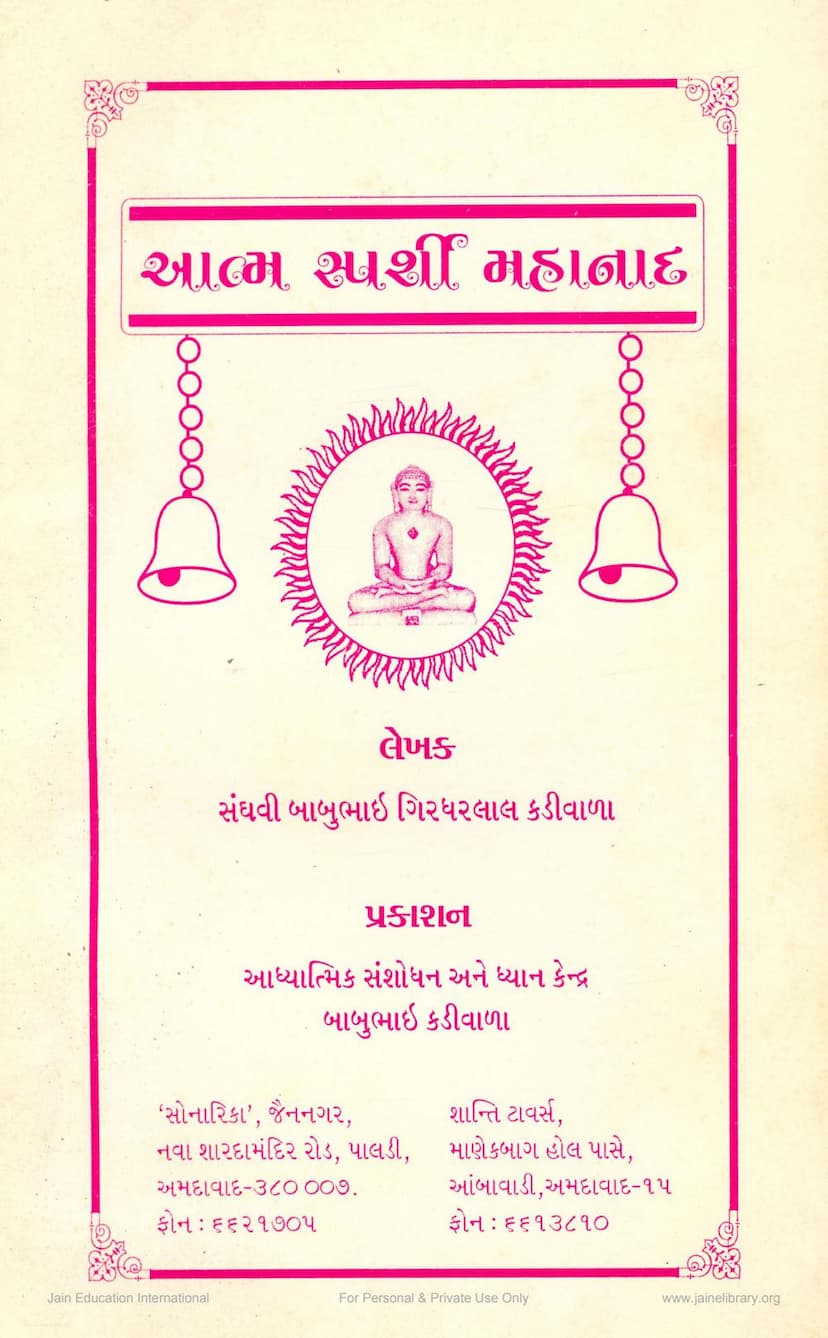Aatmsparshi Mahanad
Added to library: September 1, 2025

Summary
This document is a Jain text titled "Aatmsparshi Mahanad" (Soul-Touching Great Sound) by Babubhai Girdharlal Kadiwala, published by the Babubhai Kadiwala Charitable Trust. It is a spiritual discourse focusing on attaining closeness with the divine, particularly the Tirthankaras (Jain spiritual conquerors), through meditation, devotion, and understanding of Jain philosophy.
Here's a comprehensive summary of the text:
Core Message: The book emphasizes the transformative power of divine love and meditation (Bhavana) to achieve spiritual growth, self-realization, and ultimately, liberation (Moksha). It highlights the importance of cultivating positive thoughts and emotions, aiming to elevate one's consciousness from self-centeredness to God-centeredness.
Key Themes and Concepts:
- The Greatness of Tirthankaras: The text begins by extolling the virtues and significance of Tirthankaras, explaining that understanding their greatness fosters reverence and devotion. It states that by meditating on an Arihant (a perfected soul), one can also become like an Arihant.
- The Power of Devotion and Meditation: The central argument revolves around the practice of meditation and devotion as a path to spiritual realization. The book uses the analogy of sugar dissolving in milk to describe the merging of the individual soul with the divine, leading to ultimate bliss (Paramanand).
- Inner Transformation: The text explains that true spiritual progress leads to an inner transformation. A person can evolve from an ordinary individual into a "Maha-manav" (great human) by shifting their focus from self to the divine. This transformation brings peace, faith, and spiritual merit.
- The Role of the Guru: The teachings of the spiritual guide (Guru) are highlighted as crucial. The book emphasizes that a Guru who has experienced the soul and the divine can guide disciples towards self-realization. The Guru's grace is seen as a catalyst for spiritual awakening, transforming negative tendencies into positive ones and self-interest into selfless service.
- The Concept of "One Plus One = One": The book presents a unique philosophical perspective where "1+1=2" is the language of mathematics, but "1+1=1" is the language of love and devotion. In this spiritual context, when the devotee merges completely with the divine, duality disappears, leading to unity. This is extended to spiritual numbers like "1 lakh + 1 = 1," "1 billion + 1 = 1," and "infinity + 1 = 1," representing the absorption of the limited into the infinite.
- Spiritual Anatomy and Meditation: The text offers a visualization for meditation, describing the divine presence in the heart as a multi-tiered structure adorned with jewels. It details the manifestation of divine qualities like love, compassion, joy, strength, and prosperity from this divine presence within the meditator.
- Universal Compassion and Welfare: A significant emphasis is placed on the desire for the welfare of all beings ("Savi Jeev Karu Shasan Rasi" - May all beings become devoted to the Jain faith). This universal compassion is presented as the driving force behind the Tirthankaras' mission and a crucial element in spiritual evolution.
- The Nature of the Soul: The book touches upon the soul's nature as having both contraction and expansion. It explains that in a state of deep spiritual practice, the soul expands to encompass the entire universe.
- The Path to Moksha: The text outlines the progressive stages of spiritual realization, from developing faith (Samyak Darshan) to practicing vows (Vitrati) and ultimately achieving liberation from the cycle of birth and death.
- The Significance of "Matra Dhyan" (Quantified Meditation): The book elaborates on a specific form of meditation where the practitioner visualizes oneself as a Tirthankara, delivering sermons in a Samavasarana (divine assembly). This visualization, by establishing a spiritual "quantity" or identity of being a Tirthankara, is believed to lead to the realization of one's own divine nature.
- The Power of Right Association: The text stresses the importance of avoiding negative influences and associating with positive spiritual elements to achieve success in meditation and spiritual practice. Just as touching hot embers burns the body, engaging with negative thoughts can corrupt the mind.
- The Role of Tirthankar-naming Karma: The book discusses the specific karma that leads to becoming a Tirthankara, highlighting that this karma is tied to the aspiration for universal welfare.
- Devotion to the Arihants: The text concludes by emphasizing the profound love and devotion towards the Arihants as the root of all spiritual attainments. It encourages prayer for the manifestation of this divine love within oneself and all beings.
- Appendices: Several appendices provide further insights, including the purpose of Tirthankar-naming karma, the significance of the Siddha Chakra Puja, the practice of the Namaskar Mantra, and the teachings of revered Jain Acharyas like Haribhadrasuri.
In essence, "Aatmsparshi Mahanad" is a guide to spiritual awakening, rooted in Jain philosophy, advocating for deep meditation, unwavering devotion, and universal compassion as the keys to unlocking the soul's true potential and achieving ultimate bliss.